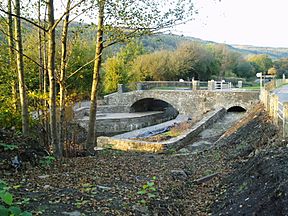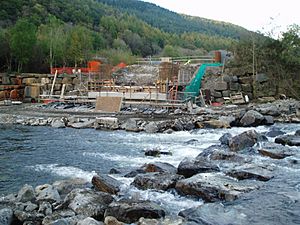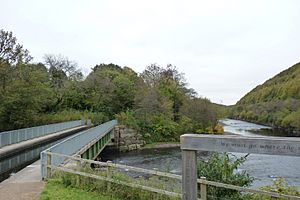Neath and Tennant Canal facts for kids
The Neath and Tennant Canals are two separate but connected canals in South Wales. People usually think of them as one long canal. The Neath Canal opened in 1795, running from Glynneath to Melincryddan, near Neath. It was extended to Giant's Grave in 1799 to help ships load and unload goods. Later, it reached its final stop at Briton Ferry.
The Neath Canal was very successful. It was about 13.5 miles (21.7 km) long and had 19 locks. The Tennant Canal started as the Glan-y-wern Canal. This older canal moved coal from a mine across Crymlyn Bog to the River Neath. It closed after 20 years.
In 1818, George Tennant made the Glan-y-wern Canal bigger and longer. He wanted to connect the River Neath to the River Tawe at Swansea docks. To get more trade, he built an extension to Aberdulais basin. This connected his canal to the Neath Canal. Many boats from the Neath Canal then used the Tennant Canal. Swansea had better places to transfer goods to ships.
Boats stopped using these canals in the 1930s. But the canals were still important. They supplied water to local factories and Swansea docks. People started trying to restore the canals in 1974. The section north of Resolven was fixed in the late 1980s. More recently, the canal from Neath to Abergarwed has been restored. This work included replacing the Ynysbwllog aqueduct. This aqueduct carries the canal over the River Neath. The new one is 35-yard (32 m) long. It is thought to be the longest single-span aqueduct in Britain.
Contents
Building the Neath Canal
People were excited when the Glamorganshire Canal was approved. So, on 12 July 1790, a meeting in Neath decided to build a canal. It would run from Pontneddfechan to Neath, and then to Giant's Grave. Thomas Dadford was asked to plan the route. He suggested a path with 22 locks. Some parts would use the River Neath.
The plan for the canal was approved by an Act of Parliament on 6 June 1791. A company called The Company and Proprietors of the Neath Canal Navigation was formed. They could raise money to build the canal. Thomas Dadford was hired as the engineer. Building started from Neath, heading north towards Glynneath.
By 1792, the canal reached the River Neath at Ynysbwllog. Dadford left to work on the Monmouthshire and Brecon Canal. Thomas Sheasby took over but did not finish on time. The canal company finished the work themselves by 1795. They continued to improve the locks and other parts for several years.
There was no rush to extend the canal to Giant's Grave at first. Access to Neath for ships had improved in 1791. But a second Neath Canal Act was passed on 26 May 1798. This allowed an extension of about 2.5 miles (4.0 km) to Giant's Grave. This area had better facilities for moving goods to ships. This part of the canal was finished on 29 July 1799. It ended at a basin near Giant's Grave Pill. Flood gates helped clean the pill of mud. The whole project cost about £40,000. It included 19 locks and several small railways.
Between 1815 and 1842, more docks were built at Giant's Grave. The canal was also extended to Briton Ferry in 1832. This was done by building the Jersey Canal, which was about 0.6 miles (1 km) long. The final length of the Neath Canal was 13.5 miles (21.7 km).
How the Neath Canal Worked
The canal carried minerals like ironstone. But digging for these minerals caused mud to build up in the canal. This made it hard for boats to move. The canal company took legal action in 1811. The court agreed that the canal would become useless if nothing was done.
Trade on the canal grew steadily. Three small private branches were built to serve local industries. One branch was built in 1800 near the top of the canal. It connected to coal mines by almost 1 mile (1.6 km) of tramroad. Another branch at Aberclwyd served a limekiln in 1817. Below Neath, a 550-yard (500 m) branch connected to coal mines at Eskyn.
We don't have exact numbers for all goods carried. But in 1810, 90,000 tons of coal were moved. The money earned by the canal increased from £2,117 in 1800 to £6,677 in 1830. It is thought that about 200,000 tons of coal were carried when trade was at its best. Iron, ironstone, and fire clay were also carried.
Facilities at Giant's Grave improved. Ships could unload their heavy ballast there. This stopped them from throwing it into the river or canal. From 1818, a Harbour Board was set up in Neath. They used banks of copper slag and buoys to mark the channel. This allowed larger ships to reach Neath quays during spring tides. From 1824, when the Tennant Canal opened, much of the trade went to the port of Swansea.
The Glan-y-wern Canal
The Glan-y-wern Canal was built to connect Richard Jenkins' coal mine at Glan-y-wern to the River Neath. It ended at a place called Red Jacket Pill. Jenkins got permission to build it in 1788. The canal was finished by 1790. At Red Jacket, goods were moved from small canal boats to larger ships. The canal was used for about 20 years. It became unused after 1810.
George Tennant later used the southern part of this canal for his Tennant Canal. The northern part of the Glan-y-wern Canal, which crossed Crymlyn Bog, was no longer used by 1918. This area is now a Site of Special Scientific Interest (SSSI). It covers about 692 acres (280 ha). It is important because of its fen and wet woodland habitats. It is also a Ramsar site and a Special Area of Conservation. Rare plants and animals live here, like slender cottongrass and the fen raft spider.
The Tennant Canal
George Tennant moved to the area in 1816. He decided to lease the unused Glan-y-wern Canal. He wanted to make it bigger and extend it. He planned for it to carry barges of 30 to 35 long tons (30 to 36 t). Boats would enter the River Neath through a lock at Red Jacket. He also wanted to extend it west to the River Tawe near Swansea harbour. Tennant believed Swansea docks would be a better shipping point. He hoped the canal would help the area grow. He decided to pay for the project himself.
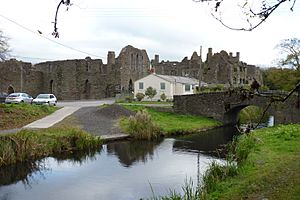
Work began in 1817. The canal was finished by autumn 1818. It ran from the River Tawe at Swansea to the River Neath at Red Jacket. The canal was built larger than planned. It could be used by barges of 50 to 60 long tons (51 to 61 t). The main canal was 4 miles (6.4 km) long. The 1.4-mile (2.3 km) branch to Glan-y-wern was also reopened. This branch supplied regular coal shipments. Other goods carried included timber, bark, fire-bricks, and sand. But there wasn't enough trade to make a profit.
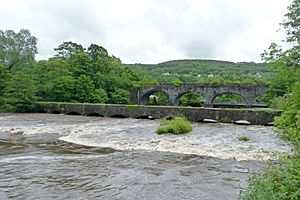
Instead of connecting to the River Neath, Tennant decided to build an extension. This would link his canal to the Neath Canal basin at Aberdulais. He started building it in 1821 without an Act of Parliament. There were engineering problems near Neath Abbey. A 500-yard (460 m) cutting was needed through what seemed like quicksand. They had to build a special masonry arch to hold the canal.
The lack of an Act caused problems in April 1821. A landowner refused permission for Tennant to cut through his land. An injunction was issued against Tennant in February 1822. Finally, Tennant offered good terms to the Neath Canal company. They accepted. The landowner, who was a Neath Canal shareholder, then agreed to talk. The final section included the only lock on the main line. It was followed by a 340-foot (100 m) ten-arched aqueduct across the River Neath. This connected to the Neath Canal. The Tennant Canal opened on 13 May 1824. It was 8.5 miles (13.7 km) long. It cost about £20,000.
At the Swansea end, Tennant built a sea-lock. This allowed boats to enter Fabian Bay. He named the area Port Tennant. His canal end was later changed when the Prince of Wales Dock was built in 1881. A new lock was built to connect the canal to the dock. Another branch of the canal was built in 1909. This included a lock into the new Kings Dock.
How the Tennant Canal Worked
Before it opened, Tennant thought the canal would carry almost 100,000 tons of goods each year. By the 1830s, it carried about 90,000 tons yearly. But the money earned was less than expected. It made about £2,500 profit per year. At first, it was called the Neath and Swansea Junction Canal. By 1845, it was known as the Tennant Canal.
The water was 5 feet (1.5 m) deep between Red Jacket and Aberdulais. It was 7 feet (2.1 m) deep from Red Jacket to Swansea harbour. This deep water helped clean the tidal basin at Port Tennant. Boats usually carried 25 tons. This meant they could also work on the Neath Canal. Several short branches were built. One opened in 1839 to the Vale of Neath Brewery. In the same year, the Glan-y-wern Canal was cleaned and reopened.
The canal mainly carried coal and culm (a type of coal). It also moved timber, iron ore, sand, and copper ore. Smaller amounts of food and other goods were carried too. New factories at Port Tennant, like a copperworks in the 1850s, increased coal traffic. Traffic reached 225,304 tons in 1866. After that, it slowly went down. But it still made money until 1895.
Why the Canals Closed
The canals faced competition from the Vale of Neath Railway after 1851. But they still made money until the early 1880s for the Neath Canal, and the 1890s for the Tennant. Most canals lowered their prices to compete with railways. But the Tennant Canal kept its prices the same, even as traffic dropped.
After 1883, the Neath Canal carried small amounts of silica and gunpowder. But traffic almost stopped by 1921. Boats stopped using the Neath Canal in 1934. The Tennant Canal stopped soon after. However, most of the canal structures were kept. This was because the canals still supplied water to local industries.
When the Glynneath bypass road was built in the 1970s, the canal was covered over in some places. This allowed the road to be made straighter and wider. In other parts, the road was built directly over the canal bed. These sections are now gone.
At Port Tennant, railways and roads now cover the canal's path. But it still supplies water to the Prince of Wales dock through a large pipe. This helps keep water levels high in the docks. The Tennant Canal is still owned by the Coombe-Tennant family.
Restoring the Canals
People are actively working to restore these canals. In 1974, the Neath and Tennant Canals Preservation Society was formed. They wanted to restore the canal and used volunteers to clear and repair it. In 2006, they changed their name to the Neath and Tennant Canals Trust. They work with local councils and other groups to bring parts of the canals back into use.
North-eastern Section Restoration
From 1974 to 1990, job creation programs helped restore the northern section. This was from Resolven to Ysgwrfa. By 1990, 3.5 miles (5.6 km) of the canal could be used by boats. This included 7 restored locks and a slipway at Resolven basin. The work won awards in 1992 and 1998. The Rheola aqueduct was fixed by the Canals Society in 1990. After the aqueduct was completed, the Canals Society launched their trip boat, Thomas Dadford, on 12 July 1990. It offered canal trips to the public.
South-western Section Restoration
In 1993, a part of the canal from Abergarwed locks to Tyn-yr-Heol lock was polluted. Water from a mine made the canal water orange. A treatment plant was built to clean the mine water. This £1.6 million project started in 1999.
In 2000, the Thomas Dadford boat moved to the southern section. It started offering boat trips from Neath town centre. At first, it could only go as far as Tonna. A £2.7 million project cleaned the polluted sections. They removed 65,000 tons of polluted mud. This extended the navigable part past Aberdulais basin to Lock Machin. This added 3 miles (5 km) more canal for boats.
To extend the canal further, a £1.6 million project was funded. This included replacing the Ynysbwllog aqueduct. Part of it had been washed away in a flood in 1979. The new aqueduct was finished in March 2008. It is 35-yard (32 m) long. It is thought to be the longest single-span aqueduct in the UK. It is 23 feet (7.0 m) wide and has footpaths on both sides. New parking and a slipway were added. The Clun locks were also fixed. This created 6 miles (9.7 km) of navigable canal from central Neath to Abergarwen. The towpath between Briton Ferry and Tonna is now a cycle route.
Future Plans for the Canals
There are still some challenges to fully restoring the canal. To connect the two navigable sections, a new bridge is needed. The original bridge is buried under a road. Rebuilding the two Abergarwed locks and Resolven lock would create a single canal about 10 miles (16 km) long. Extending the canal south is blocked by a bridge in Neath. But plans suggest replacing it with a lifting or bascule bridge.
The Tennant Canal has fewer problems. The main issues are an aqueduct below Aberdulais basin and rebuilding a lock. Fixing these would create about 20 miles (32 km) of navigable canal.
At Briton Ferry, the canal ends at a scrapyard. But there are plans to fix Brunel's Briton Ferry dock. A short extension to this dock would make a good end point for the canal. In Neath, plans for the Canal Green area could provide a canal basin and places for boats to stop.
At the other end, near Glynneath, the last five locks are cut off by a road. But this road now has less traffic. It might be possible to move the road back to its original path. The old bridge over the canal still exists there. The Neath Canal Act has not been cancelled. This means there is still a right to use this section for boats. This should make it easier to restore.
At Swansea, the Tennant Canal could be reconnected to the Prince of Wales Dock. This dock is now a large marina. This could then link to a restored Swansea Canal. There are plans to connect the Tennant Canal to the Prince of Wales Dock again. This idea was looked at in a report in 2003 and again in a recent report.
Points of Interest Along the Canals
| Point | Coordinates (Links to map resources) |
OS Grid Ref | Notes |
|---|---|---|---|
| Glynneath basin | 51°44′42″N 3°37′12″W / 51.7449°N 3.6200°W | SN882063 | northern end |
| Ysgwrfa lock | 51°44′11″N 3°39′07″W / 51.7365°N 3.6519°W | SN860054 | canal continues below here |
| Resolven basin | 51°42′52″N 3°41′57″W / 51.7144°N 3.6991°W | SN827031 | end of restored section |
| Abergarwed locks | 51°42′19″N 3°43′01″W / 51.7052°N 3.7169°W | SN814021 | unused section |
| Ynysarwed treatment plant | 51°42′05″N 3°43′34″W / 51.7015°N 3.726°W | SN808017 | end of unused section |
| Ynysbwllog aqueduct | 51°41′45″N 3°43′58″W / 51.6958°N 3.7329°W | SN803010 | fixed in 2008 |
| Aberdulais basin | 51°40′48″N 3°46′29″W / 51.6801°N 3.7748°W | SS773994 | Junction with Tennant Canal |
| Neath basin | 51°39′56″N 3°48′13″W / 51.6656°N 3.8035°W | SS753978 | southern end of restored section |
| Melincryddan wharf | 51°39′27″N 3°48′55″W / 51.6574°N 3.8152°W | SS745969 | |
| Giants Grave wharf | 51°38′17″N 3°49′40″W / 51.6381°N 3.8277°W | SS736948 | |
| Briton Ferry basin | 51°37′49″N 3°49′49″W / 51.6303°N 3.8303°W | SS734939 | filled in |
| Neath Abbey cutting | 51°39′31″N 3°50′04″W / 51.6587°N 3.8344°W | SS732971 | |
| Red Jacket pill | 51°38′10″N 3°50′43″W / 51.6362°N 3.8454°W | SS723946 | end of Glan-y-wern Canal |
| Crymlyn Junction | 51°37′35″N 3°52′43″W / 51.6263°N 3.8785°W | SS700936 | |
| End of Glan-y-wern Canal | 51°38′33″N 3°53′21″W / 51.6424°N 3.8893°W | SS693954 | |
| Swansea docks | 51°37′12″N 3°54′36″W / 51.6201°N 3.9099°W | SS678929 | end of watered section |
Getting There by Train
You can reach the area by train at Neath railway station on the South Wales Main Line.
Images for kids


